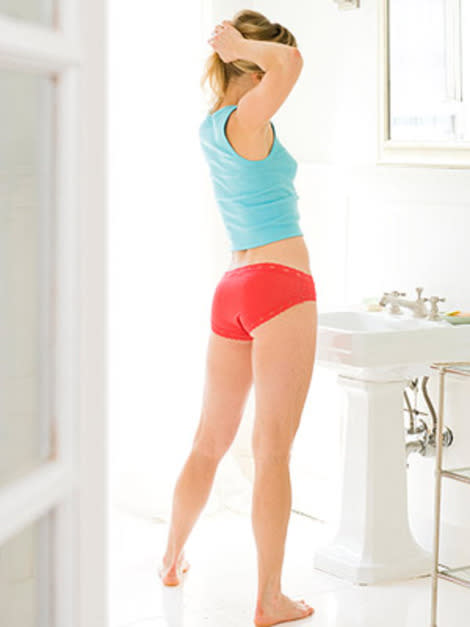How Healthy is Your Heart? 4 Easy Self-Checks

By Dimity McDowell
You don't have to get your knee whacked with a rubber hammer or a vein poked with a needle to find out. Do these easy self-checks from the comfort of your own home. Then follow doctors' orders to boost your well-being -- no copay required.
Related: More Self-Checks to Test Your Health
1. Waist circumference
Belly blubber is a time bomb. Women whose waist measures more than 35 inches have a 79 percent greater overall risk for dying from all causes, including heart disease and cancer, than those with a 28-inch or smaller waist. Place a tape measure around the widest part of your middle, usually right near your navel.
> 35 inches = Poor
32 to 35 inches = Fair
< 32 inches = Good
Health Rx
"Abs are mostly made in the kitchen," says Malissa Wood, MD, a cardiologist at Massachusetts General Hospital in Boston. Nosh on seven to nine servings of fruit and veggies and three servings of whole grains daily and two weekly servings of omega-3-rich fish, such as salmon. Aim to get 30 grams of fiber and at least 50 grams of lean protein a day. Work out, too, with an hour of cardio three or more days a week and strength training twice weekly.
2. Resting heart rate
Your RHR is a good measurement of fitness: The lower it is, the better shape you're in. Before you get out of bed in the morning, use your index and middle finger to find your pulse on your inner wrist. Count the beats for 10 seconds and multiply that number by six (this will give you your heart's beats per minute, or bpm).*
> 80 bpm = Fair (Questionable)
60 to 80 bpm = Good (Normal)
*Some superfit people have an RHR of under 60, which is great. But an RHR under 60 or above 80 could indicate dehydration or an underlying medical problem like thyroid disease or anemia. If your numbers fall into either category and you're relatively fit and well hydrated, see your doctor.
Health Rx
All cardio helps lower your RHR, but the best way to do that is through interval training, Dr. Wood says. Short bursts of high-intensity exercise increase your anaerobic threshold, which turns your heart into a more efficient muscle. Add 30- to 60-second speed intervals to a bike ride, an elliptical session, or a run once or twice a week.
Related: Get a Cardio Interval Plan Here
3. Heart rate recovery
"The faster your heart returns to its normal rate after exercise, the healthier it is," says Cheri Wiggins, MD, a physician in Twin Falls, Idaho. If your ticker's rate doesn't drop at least 12 beats within a minute post-exercise, you're at a higher risk for cardiac disease and even death. Figure out your target heart rate with this equation:
(220 - age) × 0.6 = low end of target heart rate
(220 - age) × 0.8 = high end of target heart rate
Example: a 39-year-old woman (220 - 39) × 0.6 = 109 for low end (220 - 39) × 0.8 = 145 for high end.
Now, work out -- run or cycle -- until you hit that zone. (To measure it, use a heart rate monitor.) Stop and immediately take your pulse. One minute after you stop exercising, take your pulse again. Subtract the second number from the first.
< 12 = Poor
> 12 = Good
Health Rx
If your number is less than 12, your goal is to get at least 150 minutes weekly -- or five 30-minute sessions -- of steady aerobic exercise, like power walking. Nothing too intense: On a scale of 1 (easy for you) to 10 (extremely hard), shoot for a 4 or 5. See your doctor for a checkup before you get started if you're not used to exercise. As you gain cardiovascular fitness and your heart rate recovery number gets higher, bump up your workout length and intensity.
Related: How to Eat for a Healthy Heart
4. Earlobe creases
These creases form during your adult years and are linked to coronary artery disease, high cholesterol, and diabetes. "Heart disease doesn't cause earlobe creases, nor do the creases cause heart disease, but they seem to be a marker for an unhealthy lifestyle," says Sarah Samaan, MD, a cardiologist at Legacy Heart Center in Plano, Texas, and the author of Best Practices for a Healthy Heart. One study found a correlation of as great as 80 percent between diagonal ear creases in people under age 40 and coronary artery disease. To check for creases, look for a line running at an angle from the bottom of your ear opening toward the edge of your lobe.
Crease = Poor (Higher Risk)
No Crease = Good (Lower Risk)
Health Rx
"Although you can't make creases disappear, you can minimize your risk factors for heart disease," Dr. Wood says. Know your family history; keep your weight, blood pressure, and cholesterol within a healthy range; exercise regularly; eat healthfully; and do whatever you can to reduce stress. Learn more and check your heart disease risk at goredforwomen.org.
More from FITNESS Magazine:
The Best Natural Remedies to Treat PMS
6 Ways to Rehab Your Bad Habits Now
Banish Every Bulge: Ab, Butt, and Thigh Workout
